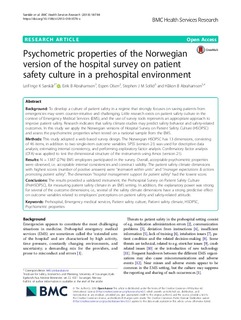| dc.contributor.author | Sørskår, Leif Inge Kjærvoll | |
| dc.contributor.author | Abrahamsen, Eirik Bjorheim | |
| dc.contributor.author | Olsen, Espen | |
| dc.contributor.author | Sollid, Stephen J. M. | |
| dc.contributor.author | Abrahamsen, Håkon Bjorheim | |
| dc.date.accessioned | 2019-01-23T13:40:16Z | |
| dc.date.available | 2019-01-23T13:40:16Z | |
| dc.date.created | 2018-11-16T20:53:00Z | |
| dc.date.issued | 2018-10 | |
| dc.identifier.citation | Sørskår, L.I. et al. (2018) Psychometric properties of the Norwegian version of the hospital survey on patient safety culture in a prehospital environment. BMC Health Services Research. 18:784 | nb_NO |
| dc.identifier.issn | 1472-6963 | |
| dc.identifier.uri | http://hdl.handle.net/11250/2581970 | |
| dc.description.abstract | Background
To develop a culture of patient safety in a regime that strongly focuses on saving patients from emergencies may seem counter-intuitive and challenging. Little research exists on patient safety culture in the context of Emergency Medical Services (EMS), and the use of survey tools represents an appropriate approach to improve patient safety. Research indicates that safety climate studies may predict safety behavior and safety-related outcomes. In this study we apply the Norwegian versions of Hospital Survey on Patient Safety Culture (HSOPSC) and assess the psychometric properties when tested on a national sample from the EMS.
Methods
This study adopted a web based survey design. The Norwegian HSOPSC has 13 dimensions, consisting of 46 items, in addition to two single-item outcome variables. SPSS (version 21) was used for descriptive data analysis, estimating internal consistency, and performing exploratory factor analysis. Confirmatory factor analysis (CFA) was applied to test the dimensional structure of the instruments using Amos (version 21).
Results
N = 1387 (27%) EMS employees participated in the survey. Overall, acceptable psychometric properties were observed, i.e. acceptable internal consistencies and construct validity. The patient safety climate dimensions with highest scores (number of positive answers) were “teamwork within units” and “manager expectations & actions promoting patient safety”. The dimension “hospital management support for patient safety” had the lowest score.
Conclusions
The results provided a validated instrument, the Prehospital Survey on Patient Safety Culture (PreHSOPSC), for measuring patient safety climate in an EMS setting. In addition, the explanatory power was strong for several of the outcome dimensions; i.e., several of the safety climate dimensions have a strong predictive effect on outcome variables related to employees’ perceptions on patient safety and safety-related attitude. | nb_NO |
| dc.language.iso | eng | nb_NO |
| dc.publisher | BioMed Central | nb_NO |
| dc.rights | Navngivelse 4.0 Internasjonal | * |
| dc.rights.uri | http://creativecommons.org/licenses/by/4.0/deed.no | * |
| dc.subject | pasientsikkerhet | nb_NO |
| dc.subject | emergency medical services | nb_NO |
| dc.subject | akuttmedisin | nb_NO |
| dc.subject | psychometric properties | nb_NO |
| dc.subject | patient safety | nb_NO |
| dc.title | Psychometric properties of the Norwegian version of the hospital survey on patient safety culture in a prehospital environment | nb_NO |
| dc.type | Journal article | nb_NO |
| dc.type | Peer reviewed | nb_NO |
| dc.description.version | publishedVersion | nb_NO |
| dc.rights.holder | © The Author(s) 2018 | nb_NO |
| dc.subject.nsi | VDP::Medisinske Fag: 700::Helsefag: 800 | nb_NO |
| dc.source.pagenumber | 1-14 | nb_NO |
| dc.source.volume | 18:784 | nb_NO |
| dc.source.journal | BMC Health Services Research | nb_NO |
| dc.identifier.doi | 10.1186/s12913-018-3576-x | |
| dc.identifier.cristin | 1631607 | |
| cristin.unitcode | 217,8,3,0 | |
| cristin.unitcode | 217,13,2,0 | |
| cristin.unitname | Institutt for sikkerhet, økonomi og planlegging | |
| cristin.unitname | Avdeling for kvalitet og helseteknologi | |
| cristin.ispublished | true | |
| cristin.fulltext | original | |
| cristin.qualitycode | 2 | |

